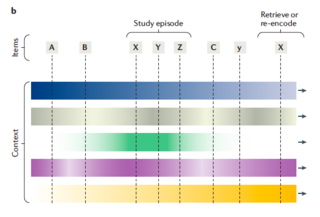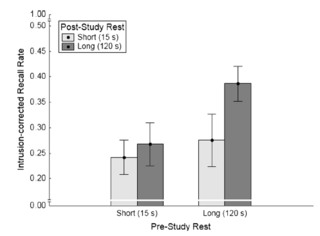Memory
Memory Is About Context, Not Consolidation
Context theories of memory can explain what consolidation can, and then some.
Posted December 17, 2019 Reviewed by Gary Drevitch
What causes forgetting? This is perhaps the most central question to memory research and motivated even the earliest memory research, yet remains hotly debated today. One of the oldest theories of memory formation is consolidation theory, dating back to Muller and Pilzecker (1900), over 100 years ago. The theory states that memories are vulnerable to forgetting after they have been encoded. Some time after a memory has been encoded it can become consolidated, at which point it becomes resistant to forgetting and can persist for a much longer duration. According to the theory, memories are like plaster in an ever-changing sculpture: It is not until the plaster dries that it becomes a permanent part of the sculpture. While consolidation originally began as an explanation of the protective effects of rest and sleep after learning has occurred, it has gained a considerable foothold in the neuroscience of memory.
Since the original proposals of consolidation theory, however, there have been a number of noteworthy developments in the theorization of memory formation and retrieval. In particular, a number of computational models have been developed that have formalized complete theories of memory, down to encoding, representations, and retrieval processes. Such models have been successful in accounting for an extremely wide range of behavioral phenomena, including forgetting functions, advantages of spaced repetitions, recency advantages, word frequency effects, and proactive and retroactive interference.
Virtually all of the models that have been built in this tradition share one major thing in common: None of the models utilize a consolidation process. Memories are formalized as bindings between items and the contexts in which they occurred; these bindings are added to the contents of memory during learning, but they are left untouched after learning occurs. The fact that such models are able to achieve such breadth without a consolidation process begs the question as to what role it plays. It does not mean that such a process does not exist, but it does undermine its explanatory role in understanding forgetting.
A recent review in Nature Reviews Neuroscience by Andrew Yonelinas, Charan Ranganath, Arne Ekstrom, and Brian Wilgten, made this very point, arguing that the class of contextual-binding models are able to explain everything consolidation can explain and then some.
Rest and Retroactive Interference
Muller and Pilzecker (1900) first proposed a consolidation explanation of retroactive interference – the finding that newly learned material interferes with retrieval of older material. They had participants study two lists of items (list 1 and list 2) and manipulated the amount of time that took place between the two lists. Not surprisingly, participants often struggle to recall list 1 items after learning the interfering list 2. You might have good memory for the sentence you’re reading at the moment, but recalling the previous sentence you’ve read might be a bit tricky.
What surprised Muller and Pilzecker is that performance on list 1 improved as the delay between the two lists was increased. Such a result is counterintuitive when one considers that delays usually harm memory. For this reason, Muller and Pilzecker reasoned that there must be a mechanism that takes place during the delay interval to improve performance on the list 1 items. They reasoned that a process of consolidation was occurring, improving performance on the list 1 items when there was a delay. When there was no delay, consolidation was prevented from occurring by the interfering list 2 material.
The benefits of rest on memory have been replicated extensively and are particularly pronounced during periods of sleep. After learning a study list, participants exhibit better memory performance if they spend the retention interval asleep than if the same period of time was spent awake (Jenkins & Dallenbech, 1924). These findings have led consolidation theorists to argue that sleep is particularly important for consolidation processes to occur.
An alternative account: Memory in context
Yonelinas and colleagues argue that each of these results can be explained by a class of models they refer to as contextual-binding theory. This theory has been implemented in a number of different computational models. It was first formulated by Bill Estes in the 1950s (Estes, 1955) but was picked up later by Gordon Bower in the early 1970s as a broader explanation of memory.
The most popular current context-based model is the temporal context model (TCM: Howard & Kahana, 2002), but context features heavily in almost all current computational models, including the SAM and REM models. Heck, I’ve even developed a context-based model (Osth & Dennis, 2015); it seems like everyone’s got one nowadays!
The core idea of the theory is that learning consists of binding items to a context representation (see the figure below). The context representation consists of both external elements such as the place and setting, but also internal elements such as the cognitive and emotional state of the individual. Critically, these elements change over time, meaning that some items from a learning episode are bound to different contextual elements than others. This is illustrated in the figure below from Yonelinas et al. in which contextual elements are arranged as vertical bars. The changes in context are illustrated by the changes in color with respect to time (depicted on the x-axis).

The only changes that occur over time are the fluctuations to the active context representation. Item-context bindings are added to memory after learning but are unchanged afterward; the bindings are unaltered or strengthened after learning occurs. It is this property that differentiates such models from consolidation theories, which argue that the learned memories are changed in important ways after learning.
At retrieval, the current state of context is used as a cue (see context state X in the figure). Following the encoding specificity principle of Endel Tulving, memories are more likely to be remembered if their contextual states at encoding match the context employed at retrieval. The contextual state at retrieval is more likely to match the most recent memories (such as Y in the figure), as context has changed very little between the current state and the context states of recently acquired memories. This yields a prediction for one of the oldest findings in memory research – the recency effect.
Context models can explain the retroactive interference data of Muller and Pilzecker (1900). In context-based models, retrieval is competitive: When context is used as a cue, memories that share contextual elements with the current cue all compete to be retrieved. This means that when two memories were studied close together in time, it may be difficult to retrieve both of them due to their similar states of context. In the figure above, one can see that the contextual states of "X" and "Y" are very similar, as there was little opportunity for the contextual states to change between their two presentations that were close together in time.
However, as time passes, each memory will have distinct context states, making them easier to retrieve independently. Consequently, context-based models can explain the finding of longer temporal intervals between List 1 and List 2 in the Muller and Pilzecker paradigm: The List 2 context is sufficiently different from the List 1 context, making it easier to retrieve memories from List 1.
Context-based theories also produce a novel prediction: Greater pauses before a relevant episode should promote better memory for the same reason – the memories of interest will have a more distinct state of context, leading to easier retrieval. This prediction was tested by Ecker, Tay, and Brown (2015) who manipulated both pre-study rest and post-study rest. They found that memory benefited from both types of rest equally! Results can be seen in the figure below.

Consolidation theory can explain the benefits of post-study rest, but it cannot explain the benefits of pre-study rest. Such a result does not invalidate consolidation theory, but the fact that the benefit is of comparable magnitude in both conditions and that such results can be easily explained by context models leaves one to wonder what the particular role of consolidation might even be.
Context models also have a simple explanation of the benefits of sleep. If memories are not acquired and stored during sleep, they cannot produce interference. Thus, a simple explanation is that waking periods simply lead to a greater proliferation of interfering memories. This may not explain the entirety of the benefits of sleep, but it does suggest that we do not require consolidation to explain the Jenkins and Dallenbach (1924) results.
Conclusions
Yonelinas et al. make a compelling case in favor of context-based models. It is essentially an argument of parsimony: We already have a theory that can explain many of the relevant phenomena a theory should explain, so why postulate additional mechanisms?
None of the arguments presented here necessarily mean that consolidation does not happen. However, they do challenge the sufficiency of consolidation in explaining retroactive interference and forgetting functions, as it is clear that memory can benefit from rest before learning and this is something consolidation cannot easily explain. Context models can explain the benefits of rest both before and after learning, but can also explain several other important phenomena in the study of memory, such as benefits of spaced learning and temporal contiguity, making the broader theory of contextual binding a suitable candidate for a unified explanation of memory function.
While context-based models have an impressive and broad coverage of existing empirical phenomena, it is also important to emphasize that our understanding of memory at longer timescales is still particularly weak, as most laboratory studies are focused on time intervals of less than one hour, as this is by far the easiest way to conduct a memory study with undergraduate participants. As more experiments are conducted with rich datasets at longer timescales, we will likely find that our existing models are too impoverished to explain all of the data.
For a fuller version of this post, which discusses forgetting functions and more computational considerations, click here.
References
Ecker, U. K. H, Tay, J-X., & Brown, G. D. A. (2015). Effects of prestudy and poststudy rest on memory: Support for temporal interference accounts of forgetting. Psychonomic Bulletin & Review, 22, 772-778.
Estes, W. K. (1955). Statistical theory of spontaneous recovery and regression. Psychological Review, 62, 145–154.
Howard, M. W. & Kahana, M. J. (2002). A distributed representation of temporal context. Journal of Mathematical Psychology, 46, 268-299.
Jenkins, J. B. & Dallenbech, K. M. (1924). Oblivescence during sleep and waking. American Journal of Psychology, 35, 605-612.
McGaugh, J. L. (2000). Memory - A century of consolidation. Science, 287, 248-251.
Muller, G. E. & Pilzecker, A. (1900). Experimentelle Beitrage zur Lehre vom Gedachtnis [Expeirmental contributions to the science of memory]. Z. Psycholog. Erganz, 1, 1-300.
Osth, A. F. & Dennis, S. (2015). Sources of interference in item and associative recognition. Psychological Review, 122, 260-311.
Rubin, D. C. & Wenzel, A. E. (1996). One hundred years of forgetting: A quantitative description of retention. Psychological Review, 103, 734-760.
Yonelinas, A. P., Ranganath, C., Ekstrom, A. D., & Wiltgen, B. J. (2019). A contextual binding theory of episodic memory: Systems consolidation reconsidered. Nature Reviews Neuroscience, 20, 364-375.




